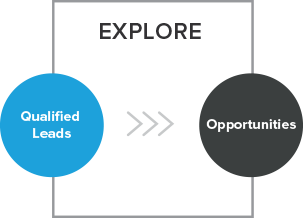Today's buyers have a wealth of information at their fingertips. Before hitting the purchase button, or talking to a sales rep, would-be customers can:
- Seek out honest, unbiased customer reviews online, via social media and sites like Capterra.
- Find competitor comparison tables, and see how your product stacks-up against its rivals.
- Learn about your business, culture, values and track-record.
But for some reason, many SaaS businesses are stuck in the past. Despite cutting-edge products and a culture of innovation, their sales processes haven't moved on since the bad old days of ABC: Always Be Closing.
It's time for a change.
The Inbound Sales Methodology
The Inbound Sales methodology was created with the modern buying process in mind. It's a departure from old-school sales tactics, and uses technology and customer data to serve the buyer, solve their problems, and create a consistent flow of new customers in the process.
There are three fundamental tenets that underpin the Inbound Sales methodology:
1) Sales needs to align with the SaaS buyer's journey
Cold outreach is growing less effective, and more costly. Modern sales needs to be smarter - understanding the buyer's journey, and reaching out with the right help and guidance, at exactly the right time.
2) Sales shouldn't be adversarial
It's no longer the role of salespeople to close the deal at all costs. Modern sales is about building trust, offering advice, and helping buyers to make the right choices.
3) Sales, Marketing and Customer Success are pieces of the same puzzle
Siloed departments create a sales process that's fragmented and inefficient. Inbound Sales is designed to work seamlessly with Inbound Marketing and Customer Success, creating a fluid, natural transition from visitor to customer to evangelist.
There are four stages to the Inbound Sales methodology - identify, connect, explore and advise - and each plays a crucial role in transitioning buyers through the awareness, consideration and decision stages of the buying process.
Identify
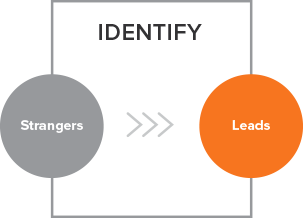 1) Use data to identify Active Buyers
1) Use data to identify Active Buyers
Inbound Sales separates active buyers from passive buyers - allowing you to make best use of your sales team's time, and reach out only to responsive prospects.
2) Understand their buyer persona
Inbound Sales helps you aggregate data from website forms, downloaded assets and visited pages, to clearly understand the unique needs of your buyers. This also helps you understand where they are in the sales process, and how you could best help.
3) create a database of Good Fit prospects
Your new-found insight can be easily saved into a Customer Relationship Management tool (like HubSpot's free CRM): creating a database of good fit prospects for your sales team to prioritise and follow-up.
Connect
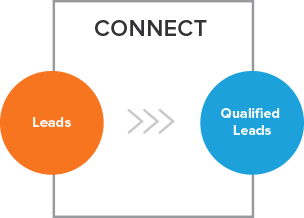 4) Connect with Prospects on Their Terms
4) Connect with Prospects on Their Terms
Instead of blasting prospects with cold phonecalls, Inbound Sales connects with prospects on their terms - using buyer persona information to identify the best way to connect with buyers, be it phone, email or social media.
5) EFFICIENTLY CONTACT INBOUND LEADS
Inbound Sales makes it easy to define sales sequences: documented outreach strategies that can be improved and optimised over time. When combined with content personalisation tools, Inbound Sales empowers sales teams with a tool-kit of effective outreach technology.
6) LEVERAGE BEHAVIOR-BASED OUTREACH
Inbound Sales uses triggered events technology to reveal which prospects are visiting your website, engaging with your emails and viewing your pricing page - making it easy to reach out at the perfect moment.
7) USE SALES-ENABLEMENT CONTENT TO ADD REAL VALUE
With Inbound Sales and Inbound Marketing working so closely together, it's easy to feed sales objections and common buying triggers into the content creation process: creating a stable of sales-enablement content that sales teams can share throughout the sales process.
Explore
8) QUALIFY YOUR PROSPECTS IN A SMART, HELPFUL WAY
Gone are the days of using BANT to qualify prospects. Inbound Sales uses a new exploratory qualification framework: allowing you to collect valuable insights, while empowering buyers to make the right decisions for their business.
9) Uncover the Prospect's Challenges and Goals
Inbound Sales is designed to uncover the prospect's challenges - barriers that are impeding their progress - and connect them with their personal and professional goals. With this crucial information, sales teams can begin to understand their current plans for tackling these challenges, and discuss why these plans aren't working.
10) Understand their TImeline and Budget
Sales teams can then work to understand the prospect's timeline, and finally, budget. With all these pieces connected together, the hard work is already done: you'll know exactly how to position your solution as an efficient and cost-effective way to overcome their challenges and realise their goals.
Advise
11) POSITION YOUR SaaS SOLUTION
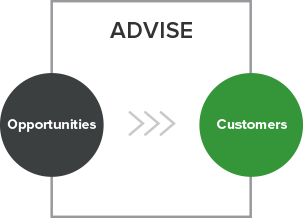 Armed with a wealth of information, the next step in the Inbound Sales process is to create a personalised, benefit-focused presentation: exploring exactly how your SaaS solution will overcome their challenges and realise their goals.
Armed with a wealth of information, the next step in the Inbound Sales process is to create a personalised, benefit-focused presentation: exploring exactly how your SaaS solution will overcome their challenges and realise their goals.
12) Propose a Timeline
With their challenges solved, and all concerns addressed, the final step is to work backwards from your proposed solution: determining exactly what your prospect needs to sign your contract, and outlining a timeline to suit.
13) Close a delighted customer
The buck doesn't stop here: with healthy MRR relying on upselling and cross-selling, Inbound Sales prioritises the importance of ongoing engagement. SaaS Sales teams should be involved in a smooth handover to Customer Success, who continue to add value, and in doing so, position the value of additional services and upgraded packages.
Getting Started with Inbound Sales
Want to get started with Inbound Sales, or looking to transform your existing SaaS sales process? Need help building a sales process from scratch? First, sign-up for your free HubSpot CRM account, and take a look around.
Next, request a free SaaS growth consultation, and we'll give you personalised advice on the best ways to develop, optimise and improve your current approach to sales.


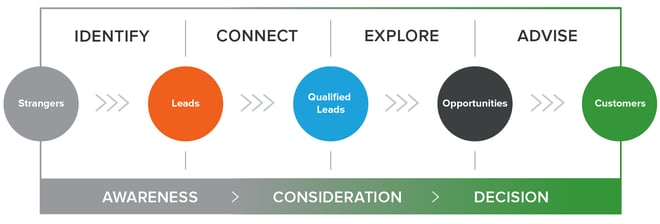
 1) Use data to identify Active Buyers
1) Use data to identify Active Buyers 4) Connect with Prospects on Their Terms
4) Connect with Prospects on Their Terms